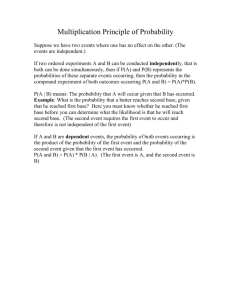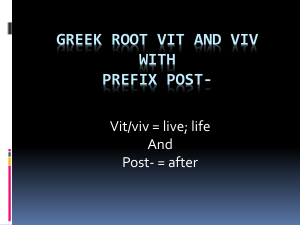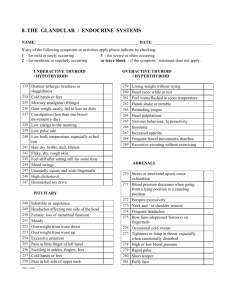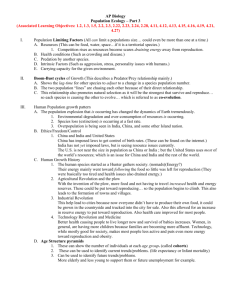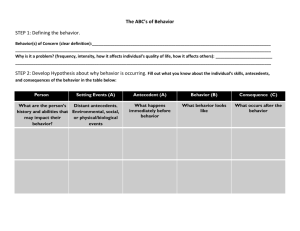Data
advertisement
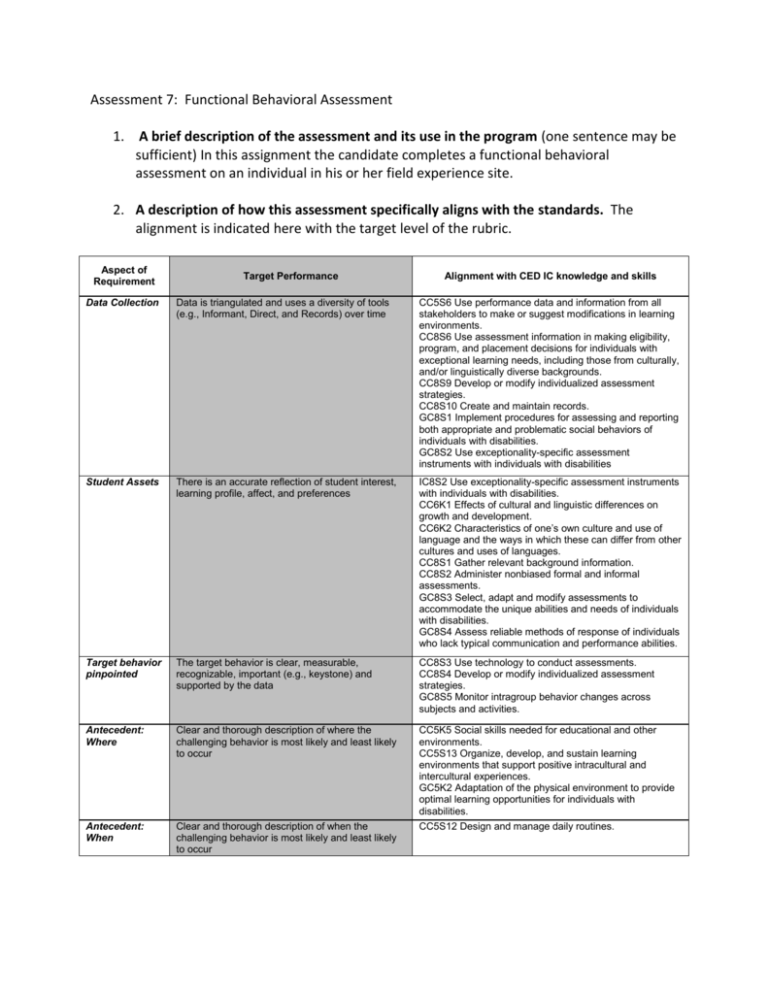
Assessment 7: Functional Behavioral Assessment 1. A brief description of the assessment and its use in the program (one sentence may be sufficient) In this assignment the candidate completes a functional behavioral assessment on an individual in his or her field experience site. 2. A description of how this assessment specifically aligns with the standards. The alignment is indicated here with the target level of the rubric. Aspect of Requirement Target Performance Alignment with CED IC knowledge and skills Data Collection Data is triangulated and uses a diversity of tools (e.g., Informant, Direct, and Records) over time CC5S6 Use performance data and information from all stakeholders to make or suggest modifications in learning environments. CC8S6 Use assessment information in making eligibility, program, and placement decisions for individuals with exceptional learning needs, including those from culturally, and/or linguistically diverse backgrounds. CC8S9 Develop or modify individualized assessment strategies. CC8S10 Create and maintain records. GC8S1 Implement procedures for assessing and reporting both appropriate and problematic social behaviors of individuals with disabilities. GC8S2 Use exceptionality-specific assessment instruments with individuals with disabilities Student Assets There is an accurate reflection of student interest, learning profile, affect, and preferences IC8S2 Use exceptionality-specific assessment instruments with individuals with disabilities. CC6K1 Effects of cultural and linguistic differences on growth and development. CC6K2 Characteristics of one’s own culture and use of language and the ways in which these can differ from other cultures and uses of languages. CC8S1 Gather relevant background information. CC8S2 Administer nonbiased formal and informal assessments. GC8S3 Select, adapt and modify assessments to accommodate the unique abilities and needs of individuals with disabilities. GC8S4 Assess reliable methods of response of individuals who lack typical communication and performance abilities. Target behavior pinpointed The target behavior is clear, measurable, recognizable, important (e.g., keystone) and supported by the data CC8S3 Use technology to conduct assessments. CC8S4 Develop or modify individualized assessment strategies. GC8S5 Monitor intragroup behavior changes across subjects and activities. Antecedent: Where Clear and thorough description of where the challenging behavior is most likely and least likely to occur CC5K5 Social skills needed for educational and other environments. CC5S13 Organize, develop, and sustain learning environments that support positive intracultural and intercultural experiences. GC5K2 Adaptation of the physical environment to provide optimal learning opportunities for individuals with disabilities. Antecedent: When Clear and thorough description of when the challenging behavior is most likely and least likely to occur CC5S12 Design and manage daily routines. Antecedent: With Whom Clear and thorough description of with whom the challenging behavior is most likely and least likely to occur CC5K4 Teacher attitudes and behaviors that influence behavior of individuals with exceptional learning needs CC5S2 Identify realistic expectations for personal and social behavior in various settings. CC5K8 Ways to create learning environments that allow individuals to retain and appreciate their own and each others' respective language and cultural heritage. Consequences and Results of the behavior A full spectrum of results are explored (e.g., immediate and distant) for all stakeholders Construction of the Behavioral Pathway Four components of the pathway are present (e.g., SE-A-B-C) and supported by the data CC5K8 Ways to create learning environments that allow individuals to retain and appreciate their own and each others' respective language and cultural heritage. GC5S5 Use skills in problem-solving and conflict resolution. Hypothesis of function/purpos e of behavior Functional hypotheses of the problem and solution are clearly presented and supported by the data CC6K3 Ways of behaving and communicating among cultures that can lead to misinterpretation and misunderstanding. Assessment 7: Functional Behavioral Assessment (Standards 5, 6, 8) 3. A brief analysis of the data findings. Candidates are consistently successful on this project. Because this is such an important knowledge and skill, candidates are given the opportunity to submit drafts and meet with the instructor. Candidates take an advantage of these opportunities and perform well. Data findings are analyzed by using visual analysis and comparing data paths across conditions of the FBA assessment. Specifically, the trend, slope, and level of the data are analyzed. 4. An interpretation of how that data provides evidence for the standards. With the alignment with standards 5, 6, and 8, this assessment provides documentation for those standards. The data provide evidence for the standard in that visual analysis is utilized to determine whether the intervention implemented from the outcomes of the FBA assessment is having an impact on student behaviors and the learning environment. 5. Attachment of assessment documentation. The assessment, (assignment as presented to the candidates) tool, scoring guide, and data are presented on the following page. A. Description of the assignment. The assignment that is given to the students states: Functional Assessment (FA)/BEHAVIOR SUPPORT PLAN – Participants will complete a functional assessment in order to complete a BSP using data collected from the current semester. Participants will complete a case study with the formulation of a hypothesis statement (e.g., a behavioral pathway). Based on the hypothesis that a behavior serves a specific purpose for the individual, this hypothesis will be tested and a behavioral support plan will be developed. The rubric is provided to help you structure your report. B. The rubric/scoring guide is: Score → Criteria ↓ 0 1 2 3 Data is triangulated and uses a diversity of tools (e.g., Informant, Direct, and Records) over time There is an accurate reflection of student interest, learning profile, affect, and preferences The target behavior is clear, measurable, recognizable, important (e.g., keystone) and supported by the data Clear and thorough description of where the challenging behavior is most likely and least likely to occur Data Collection Little or no effort to gather ongoing data was attempted Only two sources of data collection are described and not over time Data is triangulated, but not over time Student Assets Little or no description of student assets are described Student assets are present but narrow in focus, missing areas of importance There is an accurate reflection of some student assets Target behavior pinpointed Behavior is not pinpointed, more inference, and is not supported by data Behavior is pinpointed but may not be important or keystone, needs more data collection Target behavior is recognizable and important, needs more data collection Inadequate description of where the behavior is/is not occurring Where the behavior is occurring is presented, but it is not known if it is/not occurring elsewhere Where the behavior is and is not occurring is described but lacks clarity Antecedent: When Inadequate description of when the behavior is/is not occurring When the behavior is occurring is presented, but it is not known if it is/not occurring other times When the behavior is and is not occurring is described but lacks clarity Clear and thorough description of when the challenging behavior is most likely and least likely to occur Antecedent: With Whom Inadequate description of with whom the behavior is/is not occurring Who the behavior is occurring with is presented, but it is not known if it is/not occurring with others With whom the behavior is and is not occurring is described but lacks clarity Clear and thorough description of with whom the challenging behavior is most likely and least likely to occur Consequences and Results of the behavior Consequences are not described or unclearly described Consequences are described but in a way that does not lend much insight Results are considered across a spectrum, but missing some stakeholders A full spectrum of results are explored (e.g., immediate and distant) for all stakeholders Construction of the Behavioral Pathway Pathway is incomplete or not supported by data or is vaguely described The ABC (e.g., SRC) Pathway is described, but the setting event is missing Four components of the pathway are described, but more data may be needed Four components of the pathway are present (e.g., SE-A-BC) and supported by the data Hypothesis of function/purpose of behavior Function and purpose of the behavior remains hidden or unclear Function and purpose is suggested but remains unclear or vague Functional hypothesis is present for the problem, but not the solution Functional hypotheses of the problem and solution are clearly presented and supported by the data Antecedent: Where C. The data are presented on the following page. Score 1 2 Better 3 Blah OK Little or no effort to gather ongoing data was attempted Only two sources of data collection are described and not over time Data is triangulated, but not over time Data is triangulated and uses a diversity of tools (e.g., Informant, Direct, and Records) over time Little or no description of student assets are described Student assets are present but narrow in focus, missing areas of importance There is an accurate reflection of some student assets There is an accurate reflection of student interest, learning profile, affect, and preferences Behavior is not pinpointed, more inference, and is not supported by data Behavior is pinpointed but may not be important or keystone, needs more data collection Target behavior is recognizable and important, needs more data collection The target behavior is clear, measurable, recognizable, important (e.g., keystone) and supported by the data Student Assets Target behavior pinpointed 20112012 CEC/GC 2008-2009 2009-2010 CC5S6 Use performance data and information from all stakeholders to make or suggest modifications in learning environments. CC8S6 Use assessment information in making eligibility, program, and placement decisions for individuals with exceptional learning needs, including those from culturall, and/or linguistically diverse backgrounds. CC8S9 Develop or modify individualized assessment strategies. CC8S10 Create and maintain records. GC8S1 Implement procedures for assessing and reporting both appropriate and problematic social behaviors of individuals with disabilities. GC8S2 Use exceptionality-specific assessment instruments with individuals with disabilities CC6K1 Effects of cultural and linguistic differences on growth and development. CC6K2 Characteristics of one’s own culture and use of language and the ways in which these can differ from other cultures and uses of languages. CC8S1 Gather relevant background information. CC8S2 Administer nonbiased formal and informal assessments. GC8S3 Select, adapt and modify assessments to accommodate the unique abilities and needs of individuals with disabilities. GC8S4 Assess reliable methods of response of individuals who lack typical communication and performance abilities. CC8S3 Use technology to conduct assessments. CC8S4 Develop or modify individualized assessment strategies. GC8S5 Monitor intragroup behavior changes across subjects and activities. Score of 3: 26; Score of 2: 1 Score of 3: 22: Score of 2:2; Score of 1: 2 Score of 3: 29 Score of 3: 26; Score of 2: 1 Score of 3: 22: Score of 2:2; Score of 1: 2 Scores of 3: 29 Score of 3: 26; Score of 2: 1 Score of 3: 22: Score of 2:2; Score of 1: 2 Score of 3: 29 Ooh-la-la! Data Collection Criteria 0 Where the behavior is occurring is presented, but it is not known if it is/not occurring elsewhere Where the behavior is and is not occurring is described but lacks clarity Clear and thorough description of where the challenging behavior is most likely and least likely to occur CC5K5 Social skills needed for educational and other environments. CC5S13 Organize, develop, and sustain learning environments that support positive intracultural and intercultural experiences. GC5K2 Adaptation of the physical environment to provide optimal learning opportunities for individuals with disabilities. Score of 3: 24; Score of 2: 3 Score of 3: 22; Score of 2: 3; Score of 1: 1 Score of 3: 28; Score of 2: 1 Inadequate description of when the behavior is/is not occurring When the behavior is occurring is presented, but it is not known if it is/not occurring other times When the behavior is and is not occurring is described but lacks clarity Clear and thorough description of when the challenging behavior is most likely and least likely to occur CC5S12 Design and manage daily routines. Score of 3: 24' Score of 2: 3 Score of 3: 22 Score of 2: 3; Score of 2: 1 Score of 3: 24; Score of 2: 5 Inadequate description of with whom the behavior is/is not occurring Who the behavior is occurring with is presented, but it is not known if it is/not occurring with others Consequences are described but in a way that does not lend much insight With whom the behavior is and is not occurring is described but lacks clarity Clear and thorough description of with whom the challenging behavior is most likely and least likely to occur CC5K4 Teacher attitudes and behaviors that influence behavior of individuals with exceptional learning needs CC5S2 Identify realistic expectations for personal and social behavior in various settings. Score of 3: 24' Score of 2: 3 Score of 3: 21; Score of 2: 4; score of 0: 1 Score of 3: 29 Results are considered across a spectrum, but missing some stakeholders A full spectrum of results are explored (e.g., immediate and distant) for all stakeholders CC5K8 Ways to create learning environments that allow individuals to retain and appreciate their own and each others' respective language and cultural heritage. Score of 3: 25; Score of 2: 2 Score of 3: 18; score of 2: 6; score of 1: 1; score of 0: 1 Score of 3: 27; Score of 2: 2 Construction of the Behavioral Pathway Consequences and Results of the behavior Antecedent: With Whom Antecedent: When Antecedent: Where Inadequate description of where the behavior is/is not occurring Consequences are not described or unclearly described Pathway is incomplete or not supported by data or is vaguely described The ABC (e.g., SRC) Pathway is described, but the setting event is missing Four components of the pathway are described, but more data may be needed Four components of the pathway are present (e.g., SE-AB-C) and supported by the data CC5K8 Ways to create learning environments that allow individuals to retain and appreciate their own and each others' respective language and cultural heritage. GC5S5 Use skills in problem-solving and conflict resolution. Score of 3: 25; Score of 2: 2 Score of 3: 24; Score of 2: 19; Score of 2: 1 Score of 0: 2 Hypothesis of function/purpose of behavior Function and purpose of the behavior remains hidden or unclear Function and purpose is suggested but remains unclear or vague Functional hypothesis is present for the problem, but not the solution Functional hypotheses of the problem and solution are clearly presented and supported by the data CC6K3 Ways of behaving and communicating among cultures that can lead to misinterpretation and misunderstanding. Score of 3: 25; Score of 2: 2 Score of 3: 12; Score of 2: 12; score of 0: 2
